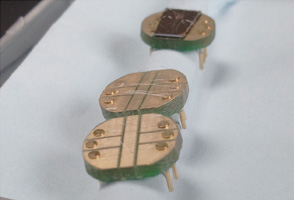We are investigating novel quantum effects in manifold condensed matter systems and devices. Research ranges from investigation of fundamental effects to device applications. Decoherence effects are very prominent in condensed matter systems and quite sophisticated devices and advanced materials have to be used to demonstrate quantum effects on extended time, length and mass scales. Here, mainly extending coherence time and length scales are in the focus of research.
Exciton-Polariton Condensate
Semiconductor micro-cavities represent a device to enable the condensation of Bosons in the solid state. Such Bosons are quasi-particles formed by bound states of electron-hole pair excitations (excitons) coupdled to light (polaritons). Aside form Bose Enstein condensates of alkali atoms, exciton-polariton condensates are considered as a model system to study quantum effects. Both ultra-fast spectroscpic experiments and theory are underway at the centre.
Superfluidity
Superfluidity is an unusual state of a liquid in which it can propagate through tiny capillaries without any resistance: the viscosity vanishes. This phenomenon was first identified at very low temperatures by a Russian scientist Piotr Kapitsa in 1937. Very recently, researchers from Paris and Madrid have made claims for superfluidity in liquid light, this being where light propagated within a crystal shows a strong interaction with the electronic excitations of the crystal.
Superfluidity of light is a new effect which is the focus of experimental and theoretical studies at the University of Southampton. Alexey Kavokin and co-authors have proposed a concept of "spin superfluidity": the state of liquid light carrying spin without any losses. Potential applications are optical integrated circuits, polariton neurons, optical spin switches etc.
Artificial Atoms
The first cavity quantum electrodynamics experiments used neutral atoms in superconducting optical cavities, but many alternatives have since appeared, one of the most successful of which has been the study of solid-state implementations. These use semiconductor-based artificial atoms, constructed from the confined electron states in artificial nanostructures. Not only do these artificial atoms allow us easily to modify the wavefunctions by engineering the confining structure, but they are also compatible with optoelectronics fabrication technologies, so we can envisage ground-breaking new integrated optoelectronic devices that are capable of both performing quantum information processing and emitting non-classical states of light. Furthermore, the extra design flexibility allows extremely large artificial atom light-matter coupling strengths to be achieved, much larger than in atomic experiments. This opens the way to the obsevation of nonperturbative phenomena of great fundamental and applied interest.
Magnetic Metamaterials
Magnetism and superconductivity are collective effects in condensed matter systems which were one of the first to enable the study of quantum menchanical effects. Also today superconducting flux qubits are amongst the hottest candidates for the realisation of a quantum computer. Our research inthis field is concentrated on ultra-fast spectroscopy of spintronic devices as well as metamaterial effects fo the guiding of electro-magnetic waves in arrays of periodically arranged magnetic structures. Interestingly enough, complex condensed matter systems can be simulated by ultra-cold atomic experiments. Intense reseach is going on.
Quantum transport in graphene: Electron Quantum Optics
Coherent transport of charge carriers or quasi-particles is at the core of mesoscopic physics for decades. Graphene provides an ideal platform which its exceptional electron transport properties. Part of our goals in this research is to realise optical elements for the coherent manipulation of electron in solid materials to enable quantum optics experiments to investigate coheence, superposition and quantum entanglement. The scalability of graphene devices to many in number and the use of mature nanofanrication technologies are welcomed incentives to work with such systems.
Polariton THz lasers emitting at THz frequencies
Recent studies of strong coupling intersubband microcavities have shown possibility of stimulated scattering of intersubband polaritons. Here we explore the possibility of generating THz radiation in semiconductor microcavities in the regime of exciton polariton lasing. The quantum efficiency of this source is governed by population of the final polariton state, which may be tuned over a large range by means of the optical pumping. Recently it was demonstrated, that rate of spontaneous emission for THz photons can be additionally increased by bosonic stimulation, when the radiative transition occurs into a condensate state. Such condensate can be formed in semiconductor microcavities with quantum wells, where Bose-Einstein condensation of exciton-polariton was recently demonstrated at room temperature. In the microcavity of specific design, THz radiative transition become allowed due to mixing of dark and bright exciton state. Enhancement of THz emission by Purcell effect and by bosonic stimulation will make the rate of THz emission comparable to decay rate, thus opening the way for development of room temperature solid state THz CW and short pulse emitter, detectors and switches. The candidate will work aims to produce a new THz spectrometer where polariton lasing is used and measured by a photoconductive antenna in a time domain experimental configuration.
People involved:
Alexey Kavokin
Pavlos Lagoudakis
Simone De Liberato
Peter de Groot
Hendrik Ulbricht
Hiroshi Mizuta
Yoshi Tsuchiya
Chees de Groot
Carlos Lobo
Janne Ruostekoski
Vasilis Apostolopoulos
